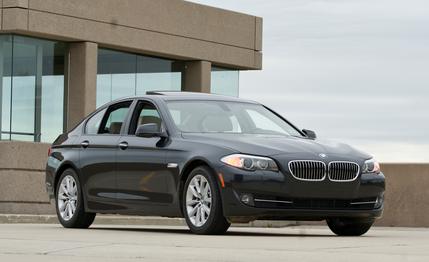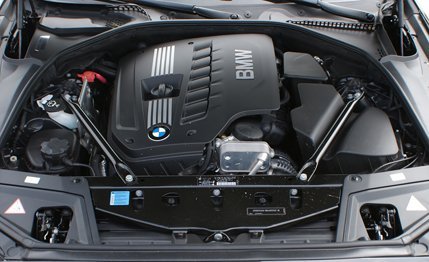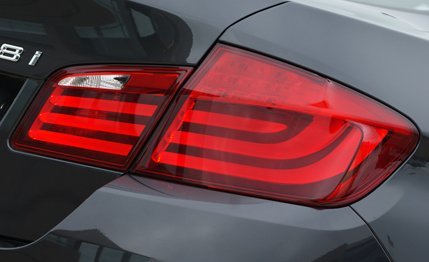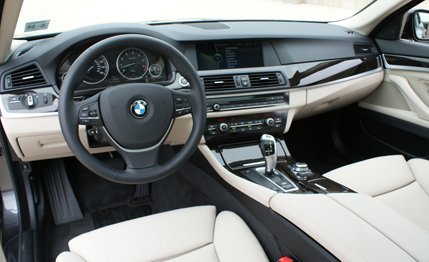
 Short Take Road Test
Short Take Road Test
In the BMW 5-series family, the 535i seems to be the sweet spot, especially compared with the V-8–powered 550i, which is unnecessarily heavy and not much quicker—not at speeds that are allowed in the U.S., anyway. But the lineup includes the 528i, and we wondered if the 5er could remain compelling, despite a power deficit.
Like the 535i, the 528i has a 3.0-liter inline-six beneath its long hood, but unlike the 535i, there’s no turbo to be found in its engine bay. For 2011, BMW went to work on the naturally aspirated engine, boosting the last-gen 528i’s output by 10 hp and 30 lb-ft, to 240 and 230. Even with the increase, going the naturally aspirated route costs you 60 hp compared with the 535i, but the cars are otherwise essentially identical, with the 535 adding 18-inch wheels (the 528i gets 17s) and adaptive xenon headlamps. Sacrificing the power keeps $5050 (or $15,150, in the case of the 550i) in your pocket.
Inline-sixes are naturally creamy, and BMW seems to possess a special mastery of the breed. In spite of its increased muscle, though, the 3.0-liter’s torque output is still relatively low, and the power peaks late in the rev range—all 240 hp are not realized until 6600 rpm. And so, with our test car weighing in at 3916 pounds, a lot was asked of the engine.


The only transmission available on the entry-level 5-series is a ZF automatic packing eight forward ratios. Although we’d prefer a manual, the automatic’s flexibility keeps the 3.0-liter in its sweet spot well enough, and this car lags just a second behind the turbo-six car in the 0-to-60 sprint—6.4 versus 5.4. The gap shrinks by 0.1 second through the quarter-mile, at 14.9 seconds at 94 mph for the 528i versus 14.0 at 100 for the 535i. In the more real-world-relevant tests of passing acceleration from 30 mph to 50 and 50 to 70, the 528i is slower by 0.2 and 0.5 second, completing the tasks in 3.3 and 4.4 seconds.
Of course, being less powerful than the 535i means the 528i should get better fuel economy. The EPA rates the non-turbo car at 22 mpg in the city and 32 mpg on the highway and the turbo at 19/28. Our observed mileage in the 528i—19 mpg—trails what we recorded in an automatic 535i by 3 mpg. Blame the 528i’s figure on our abusive 10Best riot, which consumed an inordinate percentage of this car’s fuel budget. Real people should see much better fuel economy.


Being otherwise identical to its more-expensive siblings means the 528i shares with them a whisper-quiet interior and rich trimmings. It also shares their smooth ride, balanced handling, and overall feel, which is more like that of the luxury-oriented 7-series than the more nimble 3-series. Like the 535i, the 528 hummed around the skidpad at 0.86 g, and its 160-foot stop from 70 mph is a superstar number for a family-size sleigh.
Unfortunately, the 528i shares with the rest of the 5-series its new electric power steering. Although weighty, the setup feels artificial and provides zero feedback. Its imperturbable tracking and smooth feel will likely endear it to more-laid-back buyers, but we consider this a frightening departure from what has made BMW great. Fishing in the mainstream may be profitable, but it nets the kind of buyers who painted Toyota as an unapologetic killing machine.


The electric power steering is something all 5-series buyers have to live with, but the 528i’s only other shortcoming—not being a rocket—isn’t. Were we deciding to spend $45,000 for the 528 or $50,000 for the 535, we’d be tempted to jump to the more powerful car. (Actually, were it the test car in question, we’d pare a few items from the $13,325 pile of options and spend that money on the engine upgrade instead.) But it’s easier to be cavalier with money when you’re writing imaginary checks. For customers spending real money and finding the difference harder to swallow, as well as those attracted by its more affordable lease rates, the 528i is a fine and capable alternative to the 535i.